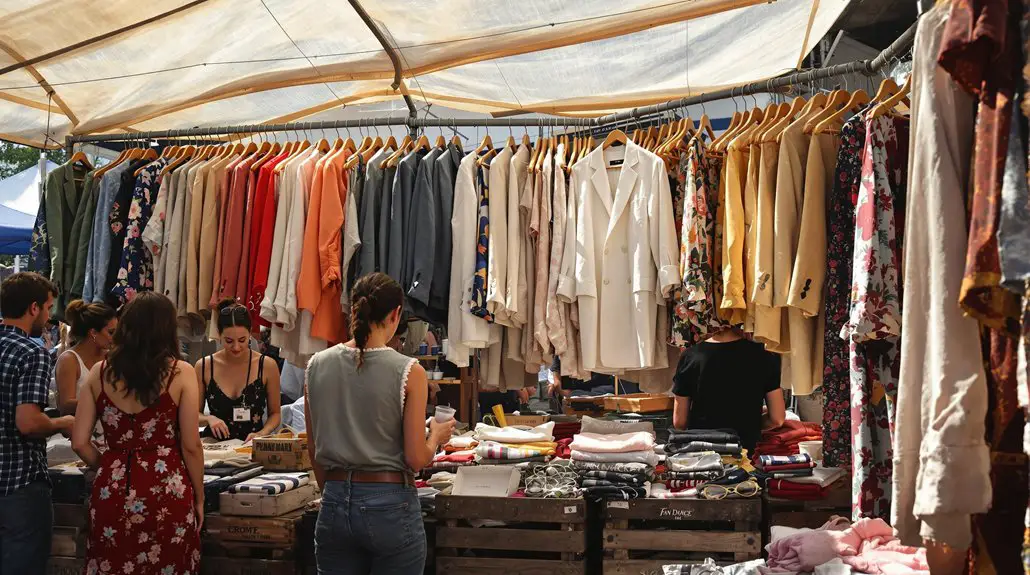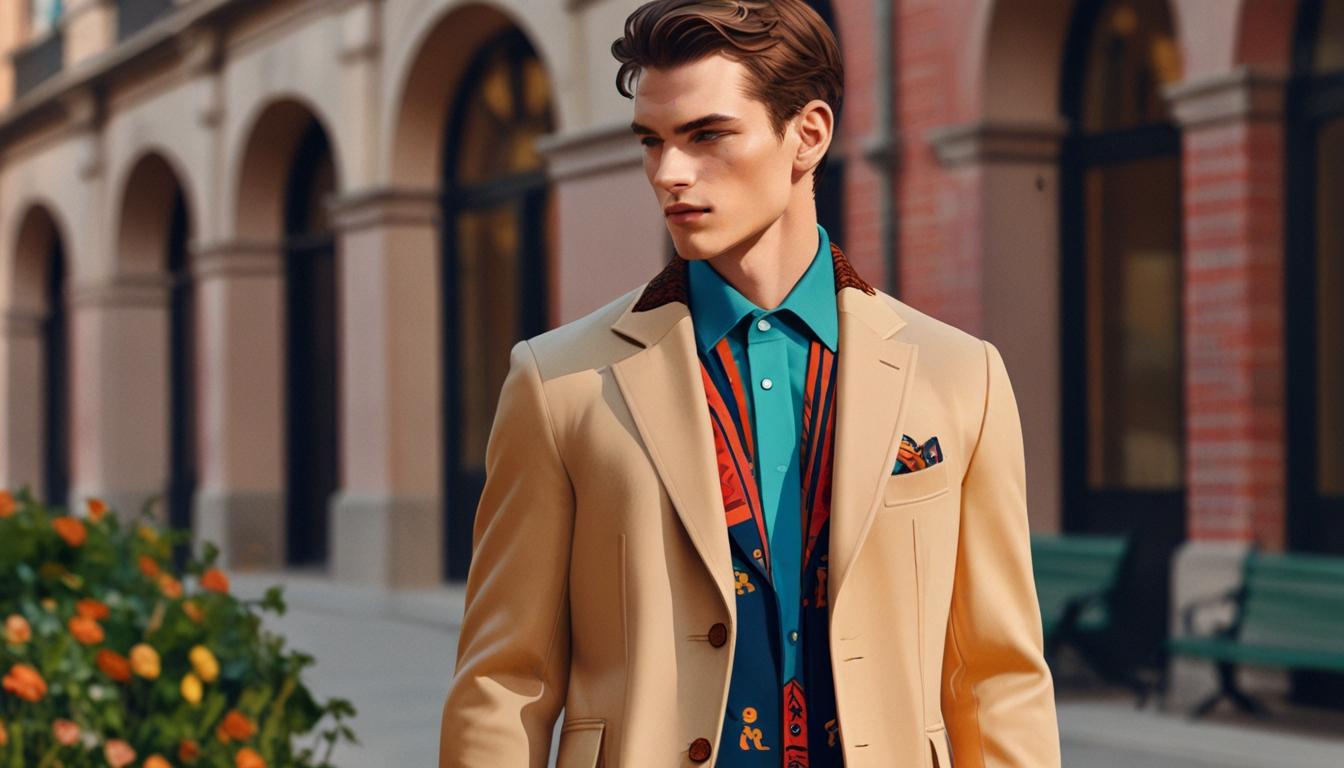In the 1960s, men's walking canes transformed into vibrant fashion statements that combined style and practicality. You'd find unique handle designs, like animal heads and intricate carvings, paired with diverse materials including wood, chrome, and brass. These canes were not just mobility aids; they reflected individuality and artistic expression, often featuring folk art inspired symbols. With options ranging from affordable to premium collectibles, they captured the interest of many. Regular maintenance was key to preserving their charm. Discover more about the enchanting designs and cultural significance that defined this decade.
Evolution of Cane Styles
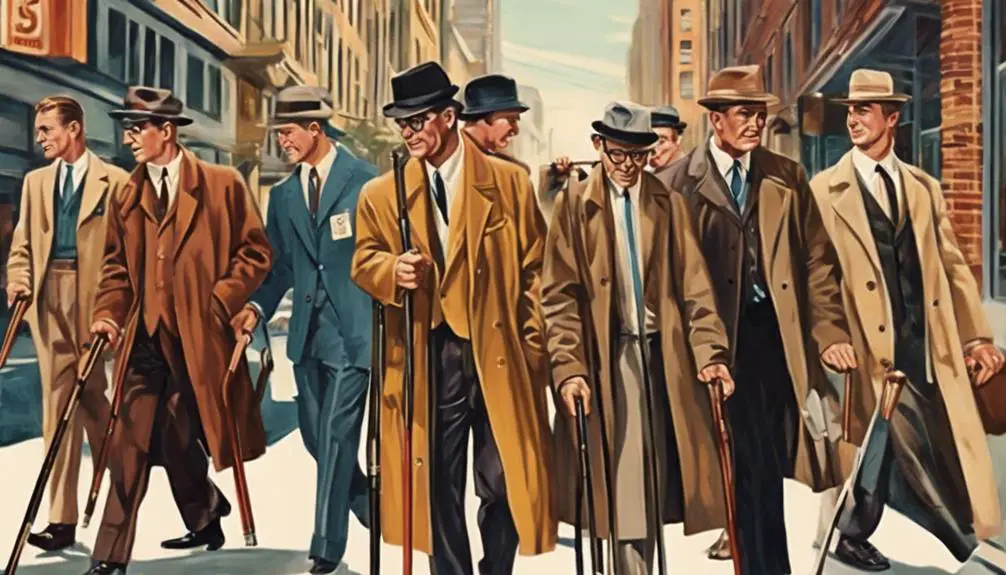
In the 1960s, cane styles evolved markedly, reflecting the decade's vibrant fashion trends. You'd notice a significant shift toward sleek designs and bold colors in walking sticks, making them not just functional but also fashionable accessories. Vintage canes from this period often incorporated unique materials like chrome and brass alongside traditional wood, showcasing a blend of modern and classic craftsmanship.
Distinctive handle designs gained popularity, with carved animal heads and intricate patterns adding a personalized touch to men's canes. These handles weren't just decorative; they often reflected the wearer's personality and interests. The era also saw a growing fascination with folk art, leading to canes adorned with cultural symbols and artistic expressions, representing individual identities.
With the emphasis on craftsmanship, prices for 1960s canes varied widely. Some collectible pieces, particularly those featuring unique materials and intricate designs, now fetch hundreds to thousands of dollars in today's market. As you explore the evolution of cane styles from the 1960s, it's clear that these walking sticks were more than mere tools; they were statements of style and individuality.
Key Features of 1960s Canes
During the 1960s, men's walking canes showcased a blend of functionality and artistic expression. These canes not only served practical purposes but also reflected the cultural shifts of the era. Here are some key features that defined 1960s canes:
- Handmade Craftsmanship: Many canes were handmade, showcasing intricate carvings and detailed craftsmanship that highlighted artisans' skills.
- Distinctive Handles: Canes often featured unique handle designs, including popular animal head handles and carved figures, adding both decorative and functional qualities.
- Material Variety: A diverse array of materials was used, such as vintage style wooden options with deep natural wood grain, chrome, and brass handles. Exotic woods like hickory and bamboo also contributed to their appeal.
- Tapered Shaft Styles: The tapered shaft walking stick design provided elegance and ease of use, making them both stylish and practical.
Whether you sought an advertising promo wood cane or a collectible masterpiece, the price range catered to different interests, from affordable options to premium pieces priced over $2,000. These features combined to make the 1960s walking stick cane an essential accessory for men.
Popular Materials Used
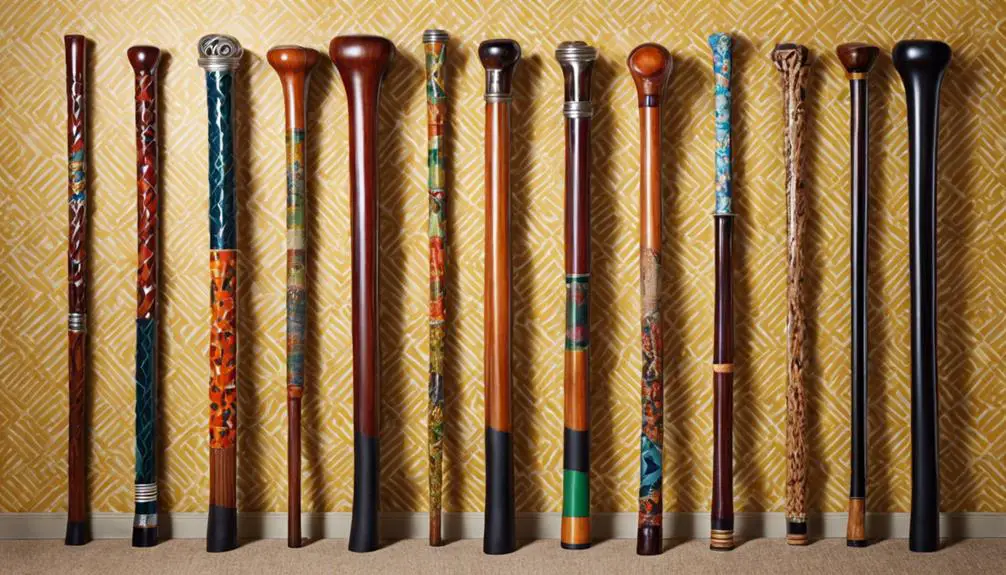
The materials used in men's walking canes during the 1960s reflect a fascinating blend of tradition and innovation. Wood remained a staple, with hickory and bamboo being particularly popular due to their durability and aesthetic appeal. These woods not only provided strength but also showcased the craftsmanship of the era.
Brass was frequently employed for decorative handles, adding an elegant touch to canes. The intricate designs of these brass handles often became focal points, enhancing the cane's overall charm. As the decade progressed, synthetic materials gained traction, allowing for lighter and more versatile walking stick designs. This shift appealed to a broader audience, merging practicality with style.
Vintage canes from this period often featured weathered finishes and a unique patina, which enhanced their character and desirability. The combination of traditional woods and modern synthetic options created a diverse market, catering to various tastes and needs. Whether you preferred the classic look of a wooden cane or the sleekness of a synthetic model, the 1960s offered a wide range of choices that reflected both personal style and the era's evolving design influences.
Unique Design Trends
Many men found walking canes in the 1960s to be more than just functional tools; they were expressions of personal style and artistry. The decade showcased a variety of unique design trends that appealed to both practicality and aesthetics.
Here are some notable features of canes from this era:
- Intricate Carvings: Canes often featured hand-carved figures, such as a Folk Art Horse or a Hand Carved Santa Claus, showcasing craftsmanship.
- Diverse Materials: Walking sticks utilized a mix of materials like chrome, brass, and bamboo, resulting in striking designs like the Brass Walking Stick Cane and Snakeskin Covered Walking Cane.
- Vintage Styles: The popularity of vintage style wooden walking canes emerged, highlighting designs that reflected cultural significance and artistic expression.
- Decorative Elements: Specialty canes often included unique accents such as regional badges, enhancing their appeal as collectible items.
Whether you preferred a Curved Handled 37 Stick or a Cane Vintage Wood Walking design, the 1960s offered a range of options that combined functionality with artistic flair, making each walking stick a personal statement.
Notable Cane Artisans
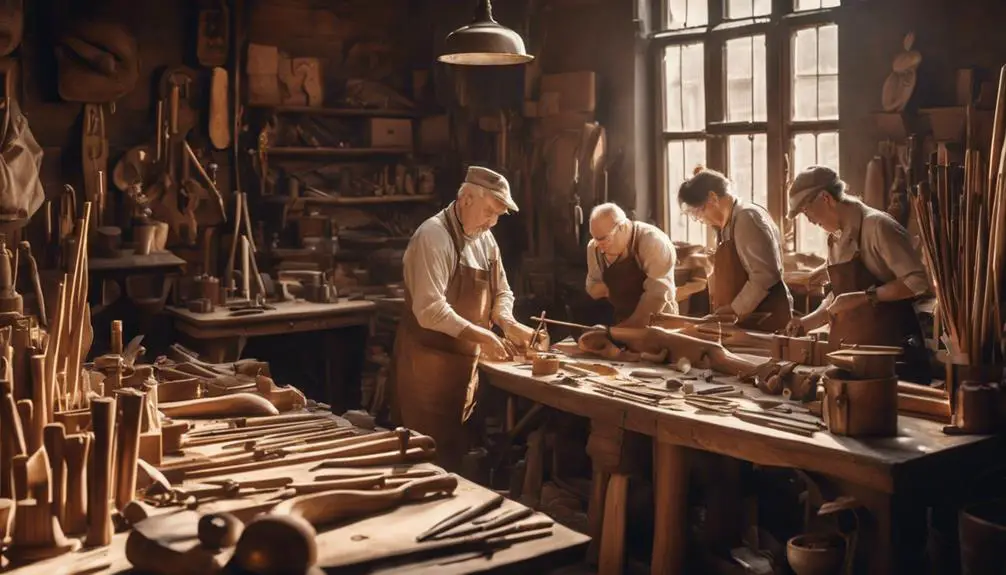
Artisans in the 1960s played a pivotal role in the evolution of walking cane design, elevating these items from mere tools to significant works of art. Notable cane artisans showcased unique craftsmanship, with many canes being handmade and intricately carved from materials like wood and brass. This era saw specialty canes featuring elaborate designs, such as animal heads and regional badges, reflecting the cultural significance of the time.
Among the distinguished artisans, the Comoys of London collection gained recognition for high-quality craftsmanship and exclusive designs that appealed to discerning cane enthusiasts. Vintage canes from this period, like the German Ice Pick Walking Stick, incorporated multiple metal city badges, combining artistry with a collector's fascination for travel and history.
Unique pieces, such as the Hand Carved Woman Cane, exemplify the intricate designs that have made these canes sought after by collectors today. The craftsmanship of these artisans not only defined the aesthetics of walking canes in the 1960s but also established a legacy that continues to influence contemporary cane design. Their work remains a reflection of the blend of functionality and artistry in the world of walking canes.
Collectibility and Market Value
A growing interest in vintage men's walking canes from the 1960s has transformed them into sought-after collectibles. Their market value varies widely, ranging from $20.02 to over $2,425.41, depending on factors like rarity and craftsmanship. Here are some key elements that influence their collectibility:
- Unique Designs: Canes with distinctive styles, such as the Hammer Head walking stick at $31.60 and the Dolphin Handle Cane priced at $98.80, attract collectors due to their artistic appeal.
- Craftsmanship: Intricate details, like those found in the Hand Carved Woman Cane valued at $425.00, emphasize the importance of quality workmanship.
- Limited Quantities: Items like the Vintage 1960s real rattlesnake skin cane at $150.00 become more desirable as their availability decreases.
- Cultural and Historical Significance: Canes such as the Korean Walking Stick from 1968, priced at $149.95, add depth to their collectibility through their historical context.
Cultural Significance of Canes
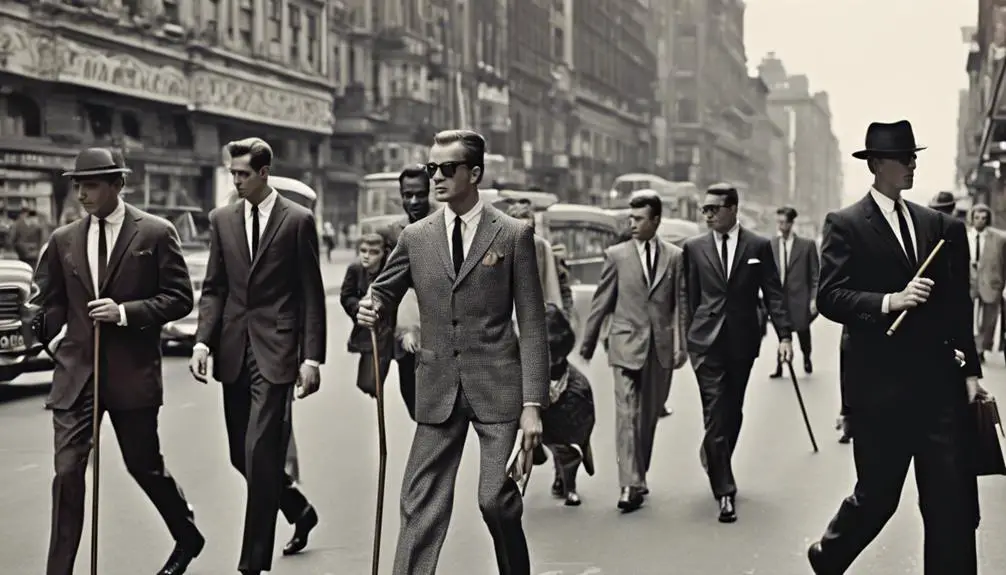
While walking canes primarily served a practical purpose, during the 1960s, they evolved into significant fashion statements for men. Their cultural significance transcended mere functionality, showcasing individuality and artistic expression during a transformative era. Canes became fashion accessories that reflected personal style and social status, often highlighting intricate craftsmanship and unique materials such as hickory and brass.
| Cane Feature | Cultural Significance |
|---|---|
| Unique Handles | Symbol of individuality |
| Intricate Designs | Showcase of craftsmanship |
| Folk Art Elements | Connection to contemporary art |
| Materials Used | Reflect elegance and status |
| Vintage Appeal | Valuable collectibles |
The 1960s also saw an appreciation for canes that symbolized elegance and sophistication, paralleling broader fashion trends emphasizing personalized, statement-making accessories. As a result, vintage walking canes with unique craftsmanship or materials are now considered valuable collectibles. They not only represent a bygone era but also encapsulate the artistic and cultural movements of their time, making them a cherished piece of history.
Practical Uses Beyond Support
Walking canes in the 1960s offered practical uses that extended well beyond mere support. These canes weren't just mobility aids; they were also stylish accessories that reflected personal flair and social standing. The unique designs of the era often showcased exceptional craftsmanship, allowing you to express your individuality. Here are some remarkable practical uses of these wooden canes:
- Fashion Statements: Canes complemented outfits, adding a touch of sophistication and style.
- Conversation Pieces: Their distinctive styles and artistic expression made them great topics for discussion.
- Hidden Features: Many canes included compartments for storing small items, enhancing their functionality.
- Unique Designs: From animal heads to intricate carvings, the artistic flair of these walking sticks captivated attention.
With materials like hickory and bamboo, these canes were not only durable but also visually appealing. They combined the practicality of mobility aids with the elegance of fashion accessories, demonstrating that even everyday items could be works of art. In the 1960s, a cane was much more than a tool; it was an extension of your personality and a reflection of your status.
Iconic Canes of the Decade
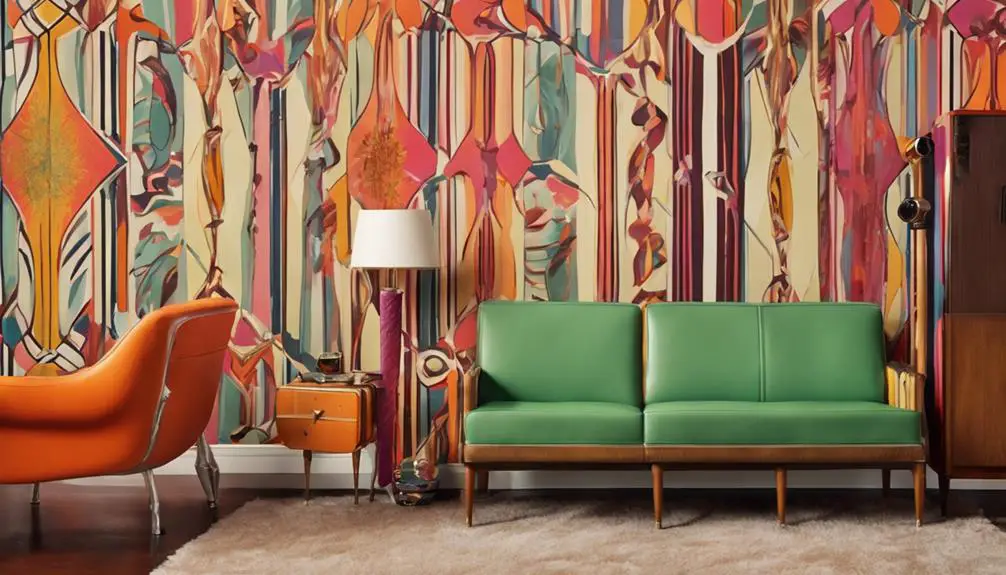
The 1960s marked a pivotal time for walking canes, as they evolved into iconic pieces that showcased not only functionality but also artistic expression. Unique designs characterized this decade, with canes featuring handles shaped like animals or figures, embodying the folk art movement. For instance, the Folk Art Deer Antler cane exemplified the era's creative spirit, while the German Bentwood Souvenir Plaque added a personal touch to these accessories.
Craftsmanship flourished with designer canes, including Vintage Brass Silver Plated options, which attracted collectors due to their rarity and retro appeal. Many walking canes also integrated practical features alongside decorative elements, balancing aesthetics with functionality. The Art Carved Striped Wood cane and the Handle Vintage Style Wooden cane became popular for their exquisite detailing.
Among notable examples were the Antique Walking Walking Cane 36 AAFA and the Handmade Wooden Hickory Small cane, both showcasing high-quality craftsmanship. The decade's canes even featured whimsical designs, such as the Carved Santa Claus Christmas cane, appealing to collectors and enthusiasts alike. Today, these vintage canes are highly sought after, with prices varying from affordable to several thousand dollars, reflecting their timeless charm.
Care and Maintenance Tips
Maintaining the beauty and functionality of your vintage walking cane from the 1960s is essential for preserving its charm and integrity. To keep your cane in top condition, follow these care and maintenance tips:
- Clean regularly: Use a soft, damp cloth to clean the cane, focusing on the handle and shaft to remove dirt and moisture that can cause damage.
- Inspect for wear: Periodically check for signs of damage, like cracks in the wood or loosened fittings. Address any issues promptly to prevent further deterioration.
- Apply wood polish: For wood canes, consider applying a suitable wood polish or wax every few months. This nourishes the wood and protects it from drying out and cracking.
- Use metal polish: If your cane has metal components, use a metal polish to remove tarnish and restore its shine. Be sure to wipe away all residue to avoid damage.
Frequently Asked Questions
When Did Men Stop Using Canes?
Men began to stop using canes regularly in the mid-20th century, particularly as fashion shifted towards casual styles. Canes evolved to specialized uses, reflecting changing social norms and perceptions of masculinity during that time.
Why Did Men Walk Around With Canes?
You might notice men carrying canes for various reasons, including mobility support, personal style, or as fashion accessories. Canes can reflect social status, confidence, and elegance, making them both functional and stylish in different settings.
What Is the History of the Gentleman's Cane?
The gentleman's cane evolved from a practical support tool to a symbol of status and elegance. By the 17th century, ornate designs showcased wealth, reflecting societal norms and the decline of swords in fashionable circles.
Are Old Walking Sticks Valuable?
Old walking sticks can be quite valuable, often ranging from $12 to over $2,400. Their worth typically hinges on rarity, craftsmanship, unique designs, and historical significance, making them appealing to collectors and enthusiasts alike.



